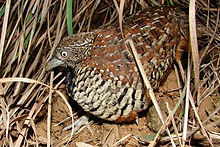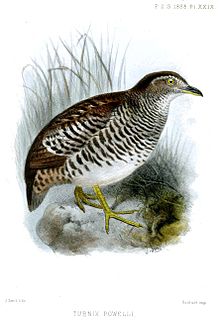- Barred Buttonquail
-
Barred Buttonquail 
Conservation status Scientific classification Kingdom: Animalia Phylum: Chordata Class: Aves Order: Turniciformes Family: Turnicidae Genus: Turnix Species: T. suscitator Binomial name Turnix suscitator
(Gmelin, 1789)The Barred Buttonquail or Common Bustard-Quail (Turnix suscitator) is a buttonquail, one of a small family of birds which resemble, but are unrelated to, the true quails. This species is resident from India across tropical Asia to south China, Indonesia and the Philippines.
Contents
Distribution
All of India up to about 2500 m in the Himalayas; Sri Lanka; Bangladesh; Burma; Indonesia and most of Southeast Asia, Philippines. Four geographical races differ somewhat in colour.
Within South Asia, it is known by many local names: Sansorai (Assam); Daoduma (Cachar); lnruibuma (Kacha Naga); Vohbubum (Kuki); Simokpho (Lepcha); linisk (Bhutea); Gulu,Gundra, Gundlu, Salui gundra (Hindi); Gulu (Bengal); Kalada - male, Pured - female (Telugu); Ankadik - male, Kurung kadik - female (Tamil); Durwa (Ratnagiri); Karechakki (Kannada); Bala watuwa (Sri Lanka).[2]
Found in most habitats except dense forest and desert. Partial to scrub jungle, light deciduous forest, and neighbourhood of cultivation.
Widespread and common throughout its large range, the Barred Buttonquail is evaluated as Least Concern on the IUCN Red List of Threatened Species.
Description
A typical little quail, rufous-brown above, rusty and buff below. Chin, throat and breast closely barred with black. Female larger and more richly coloured, with throat and middle of breast black. The blue-grey bill and legs, and yellowish white eyes are diagnostic, as are also the pale buff shoulder-patches on the wings when in flight. Absence of hind toe distinguishes Bustard and Button quails from true quails. Pairs, in scrub and grassland.
Unlike other buttonquail, are not as difficult to see, since it tends to cross, or run along, savannah tracks, and is readily viewed from a vehicle.
Feeds on insects and seeds, and is reluctant to fly.
The calls are a motorcycle-like drr-r-r-r-r-r and a loud hoon- hoon-hoon.
Nesting
Differs from true quails chiefly in the female being polyandrous.[2] The female is the brighter of the sexes, initiates courtship and builds the ground nest. She fights with other females for the possession of a cock, uttering a loud drumming drr-r-r-r-r as a challenge to rival hens and also to announce herself to a cock. Eggs when laid are left to be incubated by the cock who also tends the young, which can run as soon as they are hatched. The hen goes off to acquire another husband, and perhaps yet another, and so on, evidently only one at a time.
- Season: practically throughout the year, varying locally.
- Nest - a grass-lined scrape or depression in scrub jungle or crops, often arched over by surrounding grass. Eggs - 3 or 4, greyish white profusely speckled with reddish brown or blackish purple.
References
- ^ BirdLife International (2004). Turnix suscitator. 2006. IUCN Red List of Threatened Species. IUCN 2006. www.iucnredlist.org. Retrieved on 11 May 2006. Database entry includes justification for why this species is of least concern
- ^ a b Ali, Salim; J C Daniel (1983). The book of Indian Birds, Twelfth Centenary edition. Bombay Natural History Society/Oxford University Press.
- Birds of India by Grimmett, Inskipp and Inskipp, ISBN 0-691-04910-6
External links
- BirdLife Species Factsheet
- IUCN Red List
- Barred Buttonquail videos, photos & sounds on the Internet Bird Collection
Categories:- IUCN Red List least concern species
- Turnicidae
- Birds of Asia
- Birds of Southeast Asia
- Birds of Bhutan
- Birds of Indonesia
- Birds of Japan
- Birds of Laos
- Birds of Burma
- Birds of Nepal
- Birds of Singapore
- Birds of Bangladesh
- Birds of Cambodia
- Birds of China
- Birds of India
- Birds of Malaysia
- Birds of Pakistan
- Birds of the Philippines
- Birds of Sri Lanka
- Birds of Taiwan
- Birds of Thailand
- Birds of Vietnam
Wikimedia Foundation. 2010.



